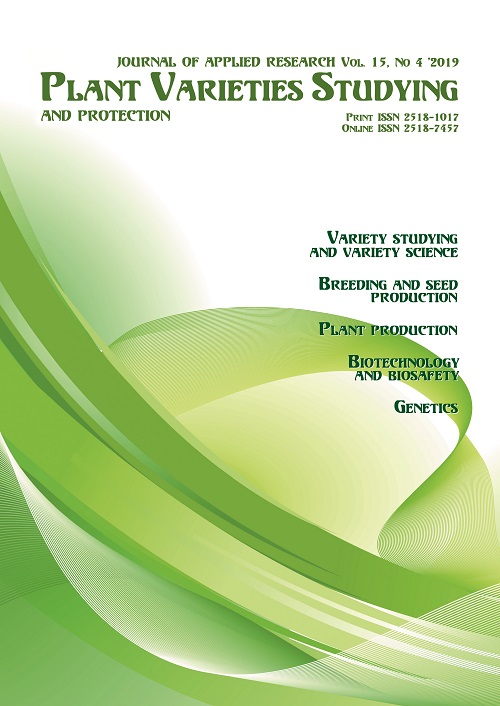Development of new guidelines for the conduct of tests for distinctness, uniformity and stability of Japanese quince (Chaenomeles Lindl.) cultivars
DOI:
https://doi.org/10.21498/2518-1017.15.4.2019.188507Keywords:
Japanese quinces, Chaenomeles, characteristics, flower, fruit, testing of varieties on the OS, UPOV method, CPVO protocolAbstract
Purpose. To develop guidelines for the conduct of tests for distinctness, uniformity and stability of Chaenomeles cultivars.
Results. Species of the genus Chaenomeles are valued as ornamental, fruit and medicinal plants. Plant Variety Database (PLUTO) includes ornamental and fruit Japanese quince varieties registered in the European Union, China, Latvia, the Netherlands, Poland, Russia, Ukraine and Japan. Neither CPVO protocols nor UPOV guidelines have been developed for Chaenomeles, but in the European Union, China, Russia and Ukraine the four national guidelines for the DUS-testing of Japanese quince varieties were published in 2003–2016. Each of them takes into account, respectively, 46, 31, 51, and 31 traits. They differ in the selection of characteristics which should always be examined for DUS and for grouping of varieties. Both flower and fruit characteristics of are the main for distinguishing Japanese quince varieties, which is facilitated by strong variability in the coloration of petals and fruits, the fruit shape and fruit weight, etc. Existing guidelines differ meaningfully in the description of these and other characteristics. Several different approaches to filling and improving the guidelines have been proposed according to the basis of Chaenomeles cultivars and species collection study and own breeding experience.
Conclusions. The new guidelines contain 42 appropriate characteristics of plant morphology, shoots, thorns, leaves, flowers, fruits, seeds as well as phenology and can be used for the conduct of tests for distinctness, uniformity and stability of all Chaenomeles cultivars.
Downloads
References
Weber, C. (1964). The genus Chaenomeles (Rosaceae). J. Arnold. Arbor., 45(2), 161–205.
Weber, C. (1964). The genus Chaenomeles (Rosaceae). J. Arnold. Arbor., 45(3), 302–345.
Mezhenskyj, V. M. (2016). On streamlining the Ukrainian names of plants. Names of some subtribe Malinae Revea taxa (information 6). Plant Var. Stud. Prot., 1, 5–11. doi: 10.21498/2518-1017.1(30).2016.61699 [in Ukrainian]
Weber, C. (1963). Cultivars in the genus Chaenomeles. Arnoldia, 23(3), 17–75.
Andriushchenko, A. V., Kryvytskyi, K. M., & Klymenko, S. V. (2016). Guidelines for the conduct of tests for distinctness, uniformity and stability. Japanese Quince (Chaenomeles japonica (Thunb.) Lindl.). In S. O. Tkachyk (Ed.), Guidelines for the conduct of tests plant varieties for distinctness, uniformity and stability (pp. 995–1005). Vinnytsia: Nilan-LТD. [in Ukrainian]
Klymenko, S. V., & Mezhenskyj, V. M. (2013). Origin of Chaenomeles Lindl. cultivars of the Ukrainian breeding. Introdukcìâ roslin [Plant Introduction], 4, 25–30. [in Ukrainian]
Mezhenskyj, V. M. (2015). On streamlining the Ukrainian names of plants. Information 5. Species names for pome fruit crops). Plant Var. Stud. Prot., 3–4, 4–11. doi: 10.21498/2518-1017.3-4(28-29).2015.58405 [in Ukrainian]
Mezhenskyj, V. M. (2009). Evolutionary changes during the breeding of Japanese quince as a fruit crop. Avtohtonnì ta ìntrodukovanì roslini [Autochthonous and Alien Plants], 5, 126–132. [in Ukrainian]
Mezhenskij, V. N. (1996). Variability of fruit quality characters in collections and selection of genotypes for breeding Chaenomeles as a fruit crop. Problems of fruit plant breeding / Latv. Univ. Agricult. Jelgava, 176–181.
Mezhenskyj, V. M. (2004). Structure and usage on non-traditional fruit crops collection. 1. Japanese quince (Chaenomeles Lindl.) Genetičnì resursi roslin [Plant Genetic Resources], 1, 123–127. [in Ukrainian]
Mezhenskij, V. N. (1989). A scale for estimating the quality of Chaenomeles fruits. In Sostoyanie i perspektivy razvitiya redkikh sadovykh kul'tur v SSSR [State and prospects for the development of rare garden crops in USSR]. (Vol. 53, pp. 117–119). Michurinsk: N.p. [in Russian]
Dolmatov, Ye. A. (1999). Japanese quince. In Ye. N. Sedov, & T. P. Ogoltsova (Eds.), Programma i metodika sortoizucheniya plodovykh, yagodnykh i orekhoplodnyck kultur [The program and methodology of variety studies of fruits, small fruits, and nuts] (pp. 473–480). Orel: VNIISPK. [in Russian]
Rumpunen, K., Kviklys, D., Kauppinen, S., Ruisa, S., & Tigerstedt, P. M. A. (2003). Breeding strategies for the fruit crop Japanese Quince (Chaenomeles japonica). In K. Rumpunnen (Ed.), Japanese Quince: Potential Fruit Crop for Northern Europe (pp. 59–80). Alnarp: Swedish Univ. Agr. Sci.
Zang, D., Ma, Y., Du, S., & Sun, J. (2011). Development of guideline for the conduct of test for distinctness, uniformity and stability of Chaenomeles new varieties. Sci. Silvae Sin., 47(6), 64–69. doi: 10.11707/j.1001-7488.20110610
Sorokopudov, V. N., & Kuklina, A. G. (2015). Japanese quince (Chaenomeles Lindl.): Guidelines for the conduct of tests for distinctness, uniformity and stability. Selektsiya, semenovodstvo i genetika [Breeding, Seed Production and Genetics], 4, 33–37. doi: 10.21685/2307-9150-2016-2-1 [in Russian]
Downloads
Published
How to Cite
Issue
Section
License
Copyright (c) 2019 В. М. Меженський, Н. П. Костенко, С. П. Лікар, М. Б. Душар

This work is licensed under a Creative Commons Attribution-ShareAlike 4.0 International License.
Our journal abides by the CREATIVE COMMONS copyright rights and permissions for open access journals.
Authors, who are published in this journal, agree to the following conditions:
1. The authors reserve the right to authorship of the work and pass the first publication right of this work to the journal under the terms of a Creative Commons Attribution License, which allows others to freely distribute the published research with the obligatory reference to the authors of the original work and the first publication of the work in this journal.
2. The authors have the right to conclude separate supplement agreements that relate to non-exclusive work distribution in the form in which it has been published by the journal (for example, to upload the work to the online storage of the journal or publish it as part of a monograph), provided that the reference to the first publication of the work in this journal is included.


























 Ukrainian Institute for Plant Varieties Examination
Ukrainian Institute for Plant Varieties Examination  Селекційно-генетичний інститут
Селекційно-генетичний інститут Institute of Plant Physiology and Genetics of the National Academy of Sciences of Ukraine
Institute of Plant Physiology and Genetics of the National Academy of Sciences of Ukraine
 The National Academy of Agrarian Sciences of Ukraine
The National Academy of Agrarian Sciences of Ukraine